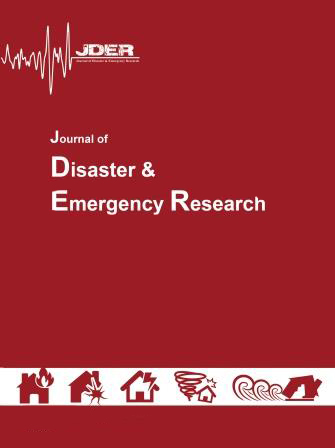Authors
1 1 CEO, vice chancellor, Deputy of Training and Research, Red Crescent Society, Mashhad, Iran
2 2.Expert in public training, Deputy of Training, Red Crescent Society, Mashhad, Iran
3 3. CEO, Red Crescent Society, Mashhad, Iran
Abstract
Introduction: Recent experiences with disasters have shown that warnings must be taken seriously and people in different groups should have necessary preparations to deal with the hazards in Iran as a natural disaster waiting country. The readiness of the relief agencies as one of the first responding organizations involved in crises as well as the readiness of their families as an effective parameter in the response of the relief agencies should be addressed. The purpose of this study was to determine the state of readiness for hazards among the staff of the Red Crescent Society of Khorasan Razavi, Iran.
Methods: This cross-sectional, descriptive study was conducted in 2018. The study population consisted of all personnel of the Red Crescent Society of Khorasan Razavi province (n: 146). Sampling was done by census. The level of preparedness was assessed and evaluated by the indicators determined by the Ministry of Health and Medical Education for assessment of the level of household readiness (HDPI) using descriptive statistics.
Results: The results showed that the lowest readiness index (2.75) was observed among the staff of the Relief and Rescue Deputy. The most qualified staff of the society were in the Education Deputy who attained the highest score (5.25).
Conclusion: Although relief the staff are expected to be present at crises immediately and conveniently, the low score in this index, that is, the lack of readiness of staff’s families, might be very effective on staff performance and could even reduce their attending the department at crisis. Therefore, special attention should be paid to promoting their readiness
Keywords
Investigating the Readiness of Red Crescent Society Staff Against Risks in Khorasan Razavi Province
Maryam Yosofi Sigari1, Mohammad Sadegh Tavakoli Sani2
- Araghizadeh H, Saghafi Nia M, Entezari V. Analyzing medical management in disasters: a review of the Bam earthquake experiences. J Military Med 2003; 5(4): 259- 68.
- Mamishi S, Sharifi I, Keshavarz H. Tehran: Ministry of Health & Medical Education Health Subcommittee for Natural Disasters Reduction & WHO press; 2010.
- Lindell MK, Prater CS. Assessing community impacts of natural disasters. Natural Hazards Review. 2003; 4(4):176-85. [DOI:10.1061/(ASCE)1527-6988(2003)4:4(176)]
- Food and Agriculture Organization (FAO). The impact of disasters on long-termfood security and poverty alleviation: Policy implications. Committee on World Food Security, 29th Session, May 12-16, 2003. Available at : http://www.fao.org/3/Y8936e/ Y8936e00.htm
- Rakhshan T, Abbasi S, Ebrahim MRi, et al. Investigating the Preparedness Status of Households against Earthquake in Fars Province in 2013; a Cross Sectional Study. Iranian Journal of Emergency Medicine.2016; 3(2):66-72 [Persian]
- Rezaei MR, Nouri M, Lashgari E. Evaluation disaster management status of Kerman city with emphasis on mental - attitude preparedness. Human Geography Research. 2018;50(4):853-71. [Persian]
- Ghadiry M, Nasabi N. An Analyzing of the Differences of Mental- Perception Preparedness of Shiraz City to Earthquake. Geographical Urban Planning Research. 2015;3(2):224-245.[Persian]
- Perry RM, Mushkatel A. Minority citizens in disasters. Athens, GA: The University of Georgia Press.1986.
- Abarquez I, Murshed Z. Field Practitioners' Handbook. Bangkok: Asian Disaster Preparedness Center; 2004. Available at: www.adpd.net/pdrsea/pubs/curriculum-cbdrm.pdf. 2004.
- Jourvand R, Sadeghirad K, Golami OA, et al. Disasters preparedness of health workers in Dehloran, Iran. Journal of Health in the Field. 2015;3(3). [Persian]
- Quarantelli EL. Disaster planning, emergency management and civil protection: The historical development and current characteristics of organized efforts to prevent and respond to disasters (Preliminary paper 227). Newark: University of Delaware, Disaster Research Center. 1995.
- National Research Council of the National Academies (NRC). Facing hazards and disasters: Understanding human dimensions. Washington, DC: The National Academies. 2006.
- Howell P, Indigenous early warning indicators of cyclones: Potential applications in coastal Bangladesh (Working paper in disaster studies and management 6). London: Benfield Hazard Research Center. 2003.
- United Nations International Strategy for Disaster Reduction (UNISDR). Terminology on disaster risk reduction. 2017; Available at: http://www .unisdr.org/we/inform/terminology.
- ICRC. The Constitution of the Red Crescent Society of the Islamic Republic of Iran. 1985. Available at: http://www.RCS.ir [Persian].
- Bradley AT, Bautista M. Handbook to practical disaster preparedness for the family. Arthur Bradley; 2010.
- Washburn C, Saunders K. Extension Disaster Education Network (EDEN): Preparing families for disaster. Journal of Family and Consumer Sciences. 2010; 102(2):61-3.
- Ezzati E, Kaviannezhad R, Karimpour H, et al. Preparedness of crisis and disaster management in social security hospitals in Kermanshah in 2016: A short report. Journal of Rafsanjan University of Medical Sciences. 2016; 15(6):583-90.[Persian].
- Ardalan A. Institutional approach in developing health emergency preparedness: The case of Iran. Proceeding of the 7th International congress on health in emergencies and disasters. Tehran: Razi 6-8 Jan 2016. [Persian]
- Ministry of Health and Medical Education. Guidance on monitoring and evaluating the household disaster preparedness plan. 2014. Available at: http://ghn.sbmu.ac.ir/ uploads/ 464_ 2885_ 1523344786342_DART_.pdf. [Persian].
- Najafi M, Ardalan A, Akbarisari A, et al. The theory of planned behavior and disaster preparedness. PLoS currents. 2017;9.
- Mirzaee F. Investigation on the safety status and preparedness of Ilam's hospitals against disasters in 2012. Journal of Ilam University of Medical Sciences. 2014; 22(7): 14-23.[Persian].
- ICRC.The National Executive's National Executive Package is prepared to deal with the dangers of "Khadem". 2016. Available from: http://khadem.ir/wp-content/ uploads/ 2018/01/ khadem - edit-4.pdf
- Mehri S, Salehi A, Ghadireh M, et al. Studying the effect of outpatient education on family preparedness and awareness about natural disasters. Quarterly Scientific Research Journal of Rescue & Relief. 2018; 9(4):18-32. [Persian].
- Jahangiri K, Azin SA, Mohammad K, Rahimi Forushani A. Factors Affecting Tehran Residents' Preparedness against Earthquake in 2007. Hakim Health Sys Res. 2010; 13 (3):155-164.[Persian].
- Islamic Parliament Research Center of The Islamic Republic Of IRAN. Comprehensive Plan Relief and salvation of the country. 2003. Available at: http://rc.majlis.ir/fa/law/show/123469

